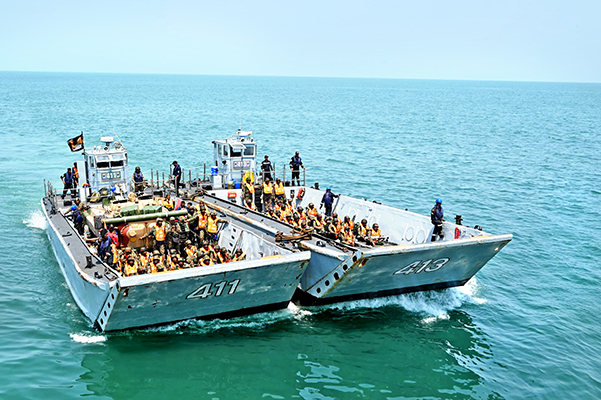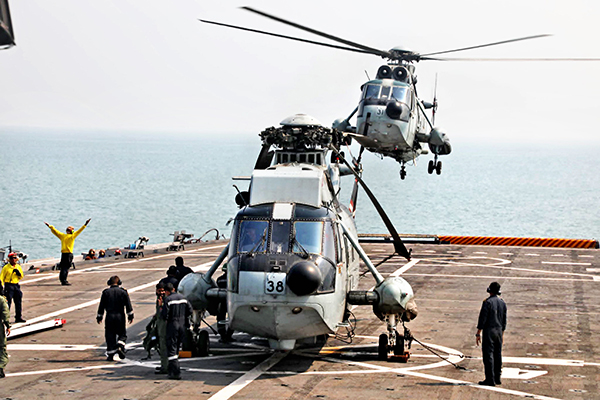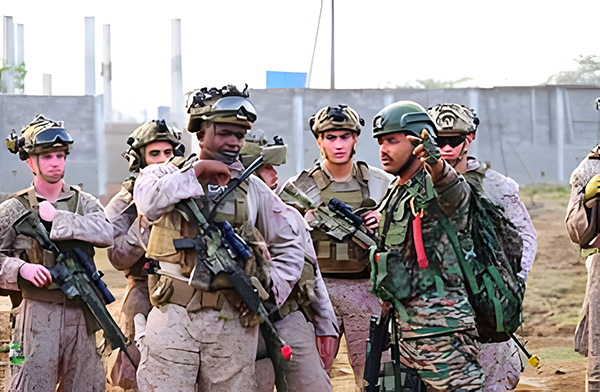



In consonance with the established partnership between India and the US, a bilateral tri-Service Humanitarian Assistance and Disaster Relief (HADR) exercise Tiger Triumph-24 was hekd on 18-31 March on the Eastern seaboard.
The 14-day exercise was aimed at developing interoperability for conducting HADR operations and refine Standard Operating Procedures (SOPs) to enable rapid and smooth coordination between forces of both countries.
Indian Navy ships with integral helicopters and landing crafts embarked the Indian Navy aircraft. Indian Army personnel and vehicles and IAF aircraft and helicopters along with the Rapid Action Medical Team (RAMT) participated in the exercise. The US was represented by its navy ships with troops drawn from the US Marine Corps and the US Army.


The Harbour Phase was held from March 18 to 25. Personnel from both navies participated in training visits, subject matter expert exchanges, sports events and social interactions. On completion of the Harbour Phase, the ships, with the troops embarked, sailed for the Sea Phase and undertook maritime, amphibious and HADR operations following injected situations.
The closing ceremony of the exercise was held onboard USS Somerset on March 30, 2024.
Cross Deck helicopter operations involving UH3H, CH53 and MH60R helicopters were also undertaken between ships of the Indian Navy and the US Navy off Kakinada and Visakhapatnam.
The participating units from the Indian Navy included a landing platform dock, landing ship tanks (large) including their integral landing crafts and helicopters, guided missile frigate and long range maritime reconnaissance aircraft.
The Indian Army was represented by one Infantry Battalion Group including mechanised forces and the Indian Air Force had deployed one medium lift aircraft, transport helicopter and the rapid action medical team (RAMT).


The US Task Force comprised of a US Navy landing platform dock including its integral landing craft air cushions and helicopters, a destroyer, maritime reconnaissance and medium lift aircraft, and also, US Marines.
Special Ops Forces from all the three Services also participated in the exercise and jointly undertook combined operations with the US counterparts at Visakhapatnam and Kakinada during the harbour and sea phase.
India’s History of HADR
In the aftermath of the Indian Ocean tsunami in December 2004, when the Indian Navy provided holistic intervention in the form of rescue and relief operations, task disaggregation, reconnaissance, and rescue of survivors in Sri Lanka, the Maldives, and Indonesia. This humanitarian assistance initiative enabled India to project its soft power as it rejected foreign aid during the crisis to demonstrate that it had the prerequisite resources and manpower to manage the crisis. In fact, to navigate the crisis, India employed indigenous resources in the form of Indian naval ships, aircraft, and helicopters to provide relief and assistance to populations of different neighboring countries like Sri Lanka and the Maldives during the disaster.
Subsequently, India provided humanitarian assistance to its South Asian neighbors during natural calamities (Bhutan, Bangladesh, Nepal, and Sri Lanka) and security conflicts (Afghanistan, Myanmar, and Sri Lanka) over the last decade, cementing its position as a first responder in crisis.


Since 2015, under India’s flagship maritime policy of “Security and Growth for All” (SAGAR), Indian Prime Minister Narendra Modi has constituted the Annual Joint HADR Exercise (AJHE), named Operation Chakravat, to demonstrate India’s capabilities in disaster risk mitigation, and disaster risk response within the IOR. Similarly, Exercise Tiger Triumph with the United States has been instituted to foster triservices engagement between the two states while having the ability to conduct amphibious HADR operations in the advent of a natural calamity. India has also furthered HADR cooperation with the United States under the aegis of the Quadrilateral Security Dialogue (Quad). The Quad has deliberated on providing coordinated responses to climate disasters while expanding its capacity, capability, and interoperability within the Indo-Pacific. In fact, the Quad sherpas organized the first Quad HADR meeting to this effect in New Delhi in December 2022.
India should invest in suitable platforms to ameliorate its HADR missions through the acquisition of utility helicopters, Landing Platform Helicopters (LPHs), and Landing Platform Docks (LPDs) to ensure faster deployments. India should acquire Multi-Role Supply Ships (MRSS) with HADR contingency load-outs that include deployable shelter systems and relief supplies. Moreover, if economically feasible, India should acquire a hospital ship like China’s Peace Ark to ameliorate Indian HADR operations.


















